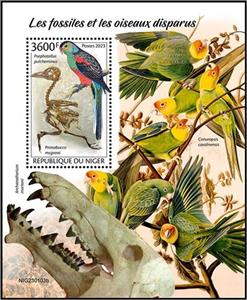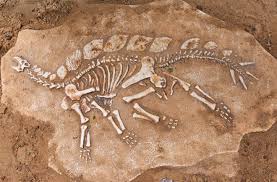Souvenir Sheet: Psephotellus pulcherrimus/Primobucco mcgrewi (Niger 2023)
Psephotellus pulcherrimus/Primobucco mcgrewi (Niger 2023)
20 April (Niger ) within release Fossils and Extinct Birds (2023) goes into circulation Souvenir Sheet Psephotellus pulcherrimus/Primobucco mcgrewi face value 3,600 West African CFA franc
| Souvenir Sheet Psephotellus pulcherrimus/Primobucco mcgrewi in catalogues | |
|---|---|
| Colnect codes: | Col: NE 2023.04.20-006 |
Souvenir Sheet is square format.
Also in the issue Fossils and Extinct Birds (2023):
- Mini Sheet - Fossils and Extinct Birds face value 4*1000;
- Souvenir Sheet - Psephotellus pulcherrimus/Primobucco mcgrewi face value 3,600;
- Stamp - Helodermoides tuberculatus, Ara tricolor face value 1,000;
- Stamp - Mesuropetala koehleri, Porphyrio albus face value 1,000;
- Stamp - Parapachydiscus quiriguinae, Fregilupus varius face value 1,000;
- Stamp - Pseudocrypturus cercanaxius, Columba versicolor face value 1,000;
Souvenir Sheet Psephotellus pulcherrimus/Primobucco mcgrewi it reflects the thematic directions:
Animals are multicellular, eukaryotic organisms of the kingdom Animalia (also called Metazoa). All animals are motile, meaning they can move spontaneously and independently, at some point in their lives. Their body plan eventually becomes fixed as they develop, although some undergo a process of metamorphosis later on in their lives. All animals are heterotrophs: they must ingest other organisms or their products for sustenance.
Birds (Aves), a subgroup of Reptiles, are the last living examples of Dinosaurs. They are a group of endothermic vertebrates, characterised by feathers, toothless beaked jaws, the laying of hard-shelled eggs, a high metabolic rate, a four-chambered heart, and a strong yet lightweight skeleton. Birds live worldwide and range in size from the 5 cm (2 in) bee hummingbird to the 2.75 m (9 ft) ostrich. They rank as the class of tetrapods with the most living species, at approximately ten thousand, with more than half of these being passerines, sometimes known as perching birds. Birds are the closest living relatives of crocodilians.
A fossil (from Classical Latin fossilis, lit. 'obtained by digging') is any preserved remains, impression, or trace of any once-living thing from a past geological age. Examples include bones, shells, exoskeletons, stone imprints of animals or microbes, objects preserved in amber, hair, petrified wood and DNA remnants. The totality of fossils is known as the fossil record. Though the fossil record is incomplete, numerous studies have demonstrated that there is enough information available to give a good understanding of the pattern of diversification of life on Earth. In addition, the record can predict and fill gaps such as the discovery of Tiktaalik in the arctic of Canada



